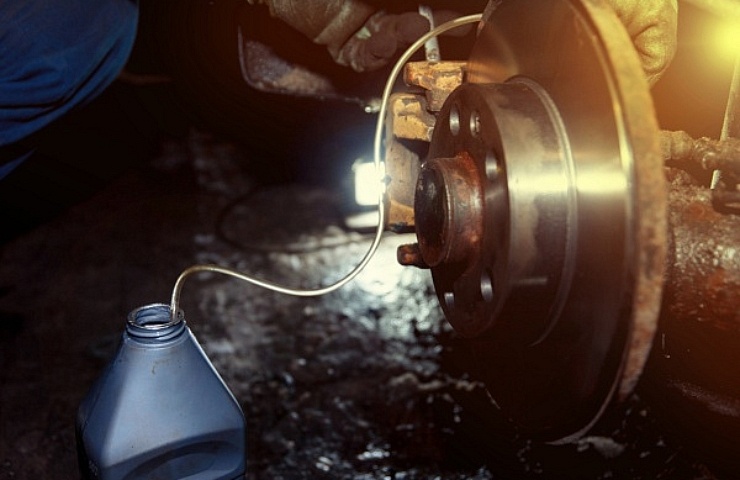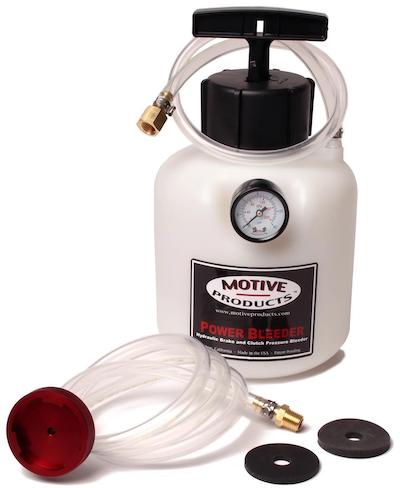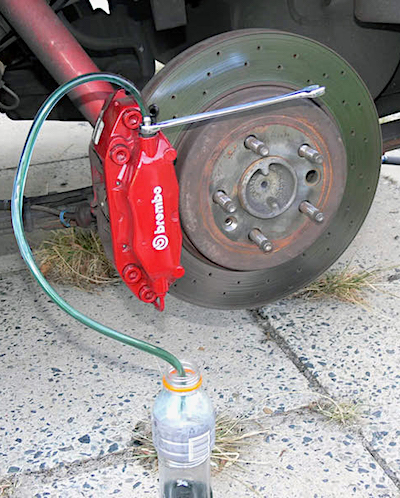Contents
The brake pedal may feel soft or spongy if there is air in your brake lines. While there’s no way to remove air from the brake lines without some form of bleeding, you can do it at home without specialized tools.
What is Brake Bleeding?
“Brake bleeding” refers to the professional procedure used on hydraulic brake systems to remove air from the lines and hoses. With the help of a brake bleeder, mechanics can purge air bubbles from the system.
Brake fluid is incompressible because it is liquid. Air bubbles are compressible because they are gas. The hydraulic pressure is affected when air bubbles get into the brake fluid. The only way to regain proper compression and pressure is to bleed the air out of the system through purging or flushing. Clean brake fluid is forced into the system, pushing the air bubbles out.
Typically, bleeding brakes involves moving the fluid out of the master cylinder into the calipers (disc brakes) or the wheel cylinders (drum brakes). Mechanics rely on five methods for brake bleeding.
- Gravity – The most straightforward way to remove air bubbles, but not always effective.
- Vacuum – The vacuum pump extracts fluids from the bleeder valve until the bubbles are removed.
- Pump/hold – The brake pedal is held down with the bleeder screw open to let the air out.
- Pressure – With a pressure pump attached to the master cylinder, bleeder valves are opened to remove the air.
- Reverse – The pump forces fluid from the bleeder valve back out of the master cylinder.
How to Get Air Out of Brake Lines Using Common Tools
Thankfully, you can get the air out without a brake bleeder. Gravity is your best friend with this method. Start by grabbing some household items, including:
- Plastic or glass containers
- Plastic hoses
- Floor jack
- Shop rags
- Funnel
- Wrench
Raise the car with your floor jack. Place jack stands at the appropriate places to support the vehicle, and follow these steps:
- Top off the master cylinder with fresh fluid.
- Locate the bleeder screws at the brake calipers or wheel cylinders. These screws are cylindrical.
- Loosen up the bleeder screws. Wear gloves to keep the brake fluid off of your skin.
- Put one end of the hoses over top of the screws.
- Put the other end of the hoses in the canisters to catch the fluid.
- Allow the fluid to drip until it contains no air bubbles.
- Remove the hoses.
- Clean off and tighten the screws.
- Refill the brake fluid in the master cylinder with a funnel.
Work with one brake at a time, starting furthest away from the master cylinder. You’ll need a friend to push on the brake pedal while you open the bleeder screw. Brake fluid should come through the hose into the canister. Close the bleeder screw when the pedal reaches the floor and repeat the process over again. Once there are no more air bubbles, this brake is done.
Repeat these steps for each wheel. Move closer to the master cylinder, ending with the closest brake. Once you are done, the brake pedal should be firm. Take the vehicle for a test drive to be sure.
Shop now for brake bleeder kitsOnce you finish, dispose of the old brake fluid safely. Take it to a fluid recycling center or participating auto parts store.
Common Brake Bleeding Mistakes
If you are attempting this process for the first time, it’s easy to make mistakes. Here are five of the most common mistakes to avoid.
- Not gathering your tools. If you attempt to remove the air from the lines without the right equipment, you could find yourself in a jam. You may need a special wrench to open the brake bleeder valve, so check on that beforehand.
- Failing to get an assistant. Two people are needed for this process. You can’t bleed the brakes and step on the pedal simultaneously.
- Forgetting to check for leaks. Before you bleed the brakes, you should inspect the system for leaks. Fix these before proceeding. Otherwise, air can get back into the line.
- Not replacing broken parts. If there are any worn-out or damaged parts, they must be replaced. Otherwise, air can infiltrate the system again.
- Failing to follow proper protocols. Following outlined procedures from your service manual is essential. While we’ve offered general guidelines, don’t do anything contrary to the manufacturer’s recommendations.
How Does Air Get Into Brake Lines?
There are a lot of myths about how air gets into the brake fluid. Some people claim it comes from pumping the brakes, causing the fluid to get agitated. Yet, this is precisely what happens with anti-lock braking systems (ABS), and air pockets don’t form.
Other people say that having old, contaminated fluid leads to air bubbles. It’s not good to have old and dirty fluid, but that won’t cause air bubbles to form.
The brake system is closed. Air shouldn’t get into the system unless there’s a problem. This happens in multiple ways.
- If the brake fluid gets too low and the master cylinder is dry.
- If the lines weren’t bled when you added new fluid or flushed the system.
- Worn or damaged components allowed air into the system. These could be worn seals or broken, cracked lines.
- Improper installation of components that aren’t properly sealed.
Once air gets in, the system must be bled to remove it. The air bubbles aren’t going to escape the closed system on their own.
Do I Have to Bleed Air Out of Brake Lines?
Air in the brake lines doesn’t just make the pedal spongy, it’s also dangerous. If you are driving on a busy highway or through an urban environment with a lot of traffic, you need the brakes to respond immediately.
Here are three reasons to get air out of the brake lines:
- Improved performance. By removing the air bubbles, you reestablish the system’s effectiveness. The pedal will be firmer, and the brakes more responsive.
- Safety. With a spongy brake pedal, it will take longer to stop. You have less control over the speed of your vehicle, leading to a potential accident. You can’t have any air in the system to achieve the fastest stopping distances.
- Prolonged brake life. Air bubbles can cause damage to vital braking components. Removing the air ensures the system operates as it should, making brake parts last longer.
The brakes get progressively worse with air bubbles in the system. Fixing the problem immediately is critical.
Remember also to change the brake fluid every 30,000 miles or two years, whichever comes first. Ensuring the fluid is fresh also improves performance.







